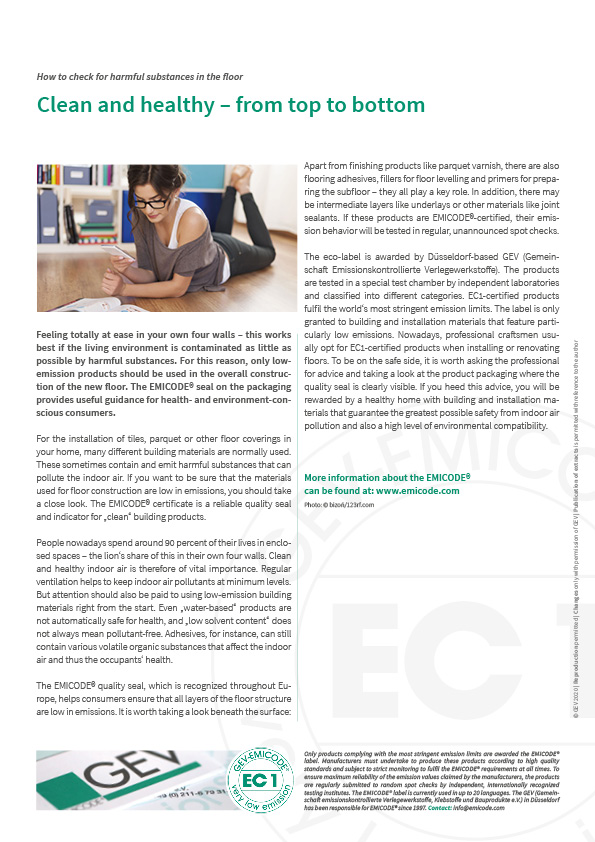Clean and healthy — from top to bottom
How to check for harmful substances in the floor
For the installation of tiles, parquet or other floor coverings in your home, many different building materials are normally used. These sometimes contain and emit harmful substances that can pollute the indoor air. If you want to be sure that the materials used for floor construction are low in emissions, you should take a close look. The EMICODE® certificate is a reliable quality seal and indicator for “clean” building products.
People nowadays spend around 90 percent of their lives in enclosed spaces – the lion’s share of this in their own four walls. Clean and healthy indoor air is therefore of vital importance. Regular ventilation helps to keep indoor air pollutants at minimum levels. But attention should also be paid to using low-emission building materials right from the start. Even “water-based” products are not automatically safe for health, and “low solvent content” does not always mean pollutant-free. Adhesives, for instance, can still contain various volatile organic substances that affect the indoor air and thus the occupants’ health.
The EMICODE® quality seal, which is recognized throughout Europe, helps consumers ensure that all layers of the floor structure are low in emissions. It is worth taking a look beneath the surface: Apart from finishing products like parquet varnish, there are also flooring adhesives, fillers for floor levelling and primers for preparing the subfloor – they all play a key role. In addition, there may be intermediate layers like underlays or other materials like joint sealants. If these products are EMICODE®-certified, their emission behavior will be tested in regular, unannounced spot checks.
The eco-label is awarded by Düsseldorf-based GEV (Gemeinschaft Emissionskontrollierte Verlegewerkstoffe). The products are tested in a special test chamber by independent laboratories and classified into different categories. EC1-certified products fulfil the world’s most stringent emission limits. The label is only granted to building and installation materials that feature particularly low emissions. Nowadays, professional craftsmen usually opt for EC1-certified products when installing or renovating floors. To be on the safe side, it is worth asking the professional for advice and taking a look at the product packaging where the quality seal is clearly visible. If you heed this advice, you will be rewarded by a healthy home with building and installation materials that guarantee the greatest possible safety from indoor air pollution and also a high level of environmental compatibility.

Photo: © bizoń/123rf.com
Feeling totally at ease in your own four walls – this works best if the living environment is contaminated as little as possible by harmful substances. For this reason, only low-emission products should be used in the overall construction of the new floor. The EMICODE® seal on the packaging provides useful guidance for health- and environment-conscious consumers.

Do You Have Questions?
If you have any questions on certain topics or want to contact us for another reason, please contact us by phone or email.
Phone: +49 (0)211 843 449 – 01
info@emicode.com
Share article on Social Media:
